Children benefit from choosing and freely exploring materials in interactive learning centers throughout your setting. Providing a space that encourages children to explore, interact with others, and use critical thinking skills without constant adult direction allows them to gain independence. Children can use independent activity centers during free play or as transition activities while waiting for others to finish a task.
Set Up the Centers
- Include materials to support current concepts and topics of interest to the children.
- Offer age-appropriate materials that can be used with minimal adult supervision.
- Promote multiple learning domains. Rotate activities that focus on language/literacy, math, science, social studies, social/emotional well-being, physical development, and creative arts (music, art, and dramatic play).
Prompt without Directing
It is very easy for providers to get caught up in leading activities. While there is purpose in teacher-led structured activities, the goal of utilizing independent activity centers is to allow children to direct their own play. They should be able to use the center freely after listening to a brief set of instructions or just by exploring the materials. Providers can extend play by asking open-ended questions to prompt further interaction. Open-ended questions begin with the words how, who, what, when, where, and why.
Providers can take an active role in participating without directing, especially during role-play. Through modeling, children can observe the provider’s actions and mimic him. For example, a teacher may provide a toy cash register and play money in the activity center. 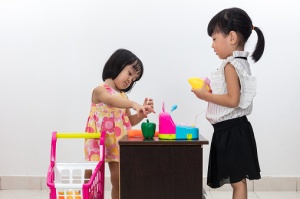 He asks the children, “Where can you find a cash register and money?” Depending on the children’s responses, he gathers additional materials such as plastic foods, bags, and grocery items. He hands the materials to the children and asks them how they could create a pretend grocery store. As the children set up, he invites them to think about roles they might play, such as customers, the cashier, and the bagger. He might suggest the children take turns acting out each role. Once the children begin playing, he observes and asks open-ended questions to support critical thinking and social interaction. The next day, he offers additional props to renew interest or looks for ways to incorporate additional learning domains. Children who learn to explore and actively seek out play opportunities on their own are likely to exhibit independence and self-management through their school years.
He asks the children, “Where can you find a cash register and money?” Depending on the children’s responses, he gathers additional materials such as plastic foods, bags, and grocery items. He hands the materials to the children and asks them how they could create a pretend grocery store. As the children set up, he invites them to think about roles they might play, such as customers, the cashier, and the bagger. He might suggest the children take turns acting out each role. Once the children begin playing, he observes and asks open-ended questions to support critical thinking and social interaction. The next day, he offers additional props to renew interest or looks for ways to incorporate additional learning domains. Children who learn to explore and actively seek out play opportunities on their own are likely to exhibit independence and self-management through their school years.
Ideas for Activity Centers
Use the ideas below to create independent activity centers throughout your setting:
LANGUAGE/LITERACY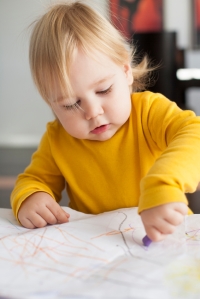
- Offer a voice recorder for children to record themselves telling a story, making animal noises, or singing.
- Create blank journals or provide paper and clipboards, along with an assortment of writing tools. Children can draw or write freely.
- Provide a white board, dry erase markers, and erasers. Allow children to draw freely, or create simple instructions for them to follow. For example, draw a shape on the board. Encourage children to copy the shape or erase it with an eraser.
SCIENCE
- Place seasonal nature items in a sensory table. Offer magnifying glasses for children to examine the items.
- Offer wood planks to serve as ramps. Encourage children to experiment with rolling toy cars down the ramps at different inclines.
- Fill containers with familiar extracts or foods that have a strong scent. Cover the top of each container with foil and seal with a rubber band. Poke holes in the top of the foil, and have children sniff the containers and guess the scents.
- Offer items near a container of water, and have children predict which items will sink and which will float. Supervise children at all times near water.
DRAMATIC PLAY-SOCIAL/EMOTIONAL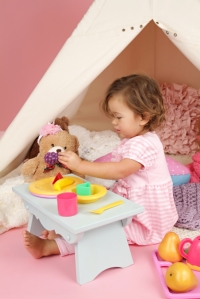
- Decorate the play area with streamers, paper cutouts, and pictures to enhance learning themes.
- Provide materials to enhance role-play. A variety of occupations and activities can be explored. The children can hold a tea party, go fishing, put on a concert, act as wild animals, or tend a pretend garden. The possibilities are endless!
- Include fiction and nonfiction books, environmental print, cookbooks, menus, magazines, and store ads to support themes and promote literacy.
MATH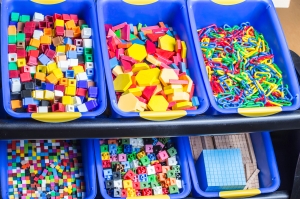
- Provide a weight scale, and invite children to weigh various items in the center. Have them predict which items will be the heaviest and lightest.
- Fill a small jar with cotton balls, and have children guess how many cotton balls are in the jar. Have the children remove the cotton balls and count them to see if their guesses were correct.
- Offer small manipulatives (beads, buttons, rocks, etc.) in various colors, shapes, or sizes to practice counting, sorting, and patterning. Supervise use of small materials closely.
PHYSICAL DEVELOPMENT
- Provide scraps of paper, scissors, and a box. Invite children to practice cutting skills by snipping the paper over the box. Use the small pieces of paper as confetti in future art projects.
- Tape pictures of animals, buildings, or community helpers to building blocks. Invite children to incorporate the prop blocks in their block play.
- Place a long wood plank on the floor. Challenge children to walk across the plank with or without holding your hand.
- Cut shapes from craft foam or felt, and have children place them on the floor to create a path. Have children jump along the path.
MUSIC
- Offer a variety of music selections to explore different music genres. Consider playing music that represents cultures and languages that have meaning to the children.
- Provide instruments, rhythm sticks, shakers, bells, etc. that can be played while dancing or singing.
- Create ribbon wands by taping ribbons or streamers to the ends of craft sticks. Invite children to twirl them in time with the music.
- Make a recording of yourself clapping a beat. Have the children play the recording and copy your beat.
ART EXPRESSION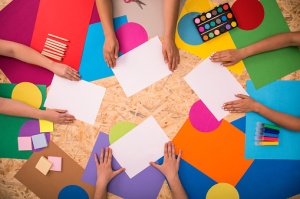
- Provide scissors, glue, tape, paper, crayons or markers, and various scrap items or leftover materials from previous projects. Invite children to create collages with the items.
- Offer paper, paint, and a variety of unusual painting tools, such as makeup applicators, sponges, bath loofahs, and netting. Invite children to explore how the items mark the paper.
- Gather an assortment of colored painter’s tape. Have children tear the tape and place the pieces on paper to create a collage or to separate the paper into sections. Have children color the exposed portions of paper with crayons or markers.
Back to blog listing